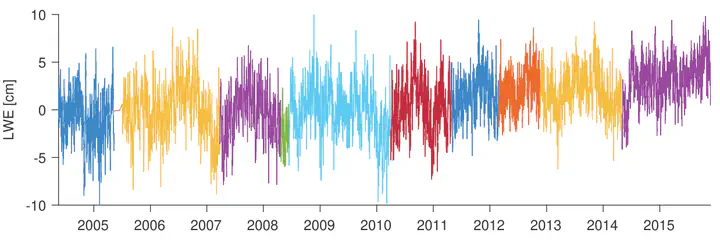Using GRACE and in situ bottom pressure recorders to evaluate external transports at 26°N
 Complete bottom pressure (as liquid water equivalent, or LWE) time series for the WB2 mooring; adjusted for instrument drift using Gravity Recovery and Climate Experiment data, with data gaps filled with a modified annual cycle, and with overlapping sections replaced by a weighted mean.
Complete bottom pressure (as liquid water equivalent, or LWE) time series for the WB2 mooring; adjusted for instrument drift using Gravity Recovery and Climate Experiment data, with data gaps filled with a modified annual cycle, and with overlapping sections replaced by a weighted mean.Abstract
The RAPID mooring array at 26°N in the Atlantic has been observing the Atlantic meridional overturning circulation (AMOC) since 2004, with estimates of AMOC strength suggesting that it has declined over the 2004–2016 period. When AMOC transport is estimated, an external transport is added to the observed Ekman, Florida Straits, and baroclinic geostrophic transports to ensure zero net mass transport across the section. This approach was validated using the first year of RAPID data by estimating the external component directly from in situ bottom pressure data. Since bottom pressure recorders commonly show low-frequency instrument drift, bottom pressure data had to be dedrifted prior to calculating the external component. Here we calculate the external component from 10 years of in situ bottom pressure data and evaluate two choices for dedrifting the records: traditional and adjusted using a Gravity Recovery and Climate Experiment (GRACE) bottom pressure solution. We show that external transport estimated from GRACE-adjusted, in situ bottom pressure data correlates better with the RAPID compensation transport (r=0.65,p<0.05) than using individually dedrifted bottom pressure recorders, particularly at low frequencies on timescales shorter than 10 years, demonstrating that the low-frequency variability added from GRACE is consistent with the transport variability at RAPID. We further use the bottom pressure-derived external transport to evaluate the zonal distribution of the barotropic transport variability and find that the transport variability is concentrated west of the Mid-Atlantic Ridge rather than uniformly distributed across the basin, as assumed in the RAPID calculation.